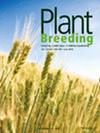rabi高粱育性恢复遗传及环境因子对雄性不育源maldandi的影响Moench]
IF 1.5
4区 农林科学
Q2 AGRONOMY
引用次数: 0
摘要
本研究旨在研究一个雄性不育系(M31‐2A)、一个maldandi细胞质和两个有前途的恢复系(DSMR‐4和DSMR‐8)之间杂交产生的杂交后代的育性恢复遗传模式。在两组实验中对杂交种进行了评价,包括F2、BC1F1和F2、F3代。对F2代和BC1F1代的分离模式进行了分析,得出可育与不育植株的比例分别为54:10和1:1。这表明有三个基因参与,其中至少两个基因必须处于显性状态才能恢复,以重复互补的方式发挥作用。在F3代,两个杂交种的生长都是为了确认恢复系的稳定性,它们以10个真育种家系和44个分离家系的比例分离,这与F2的比例一致。此外,这项研究观察到了降雨对季节性部分恢复模式的影响,因为恢复基因根据水的可用性而上调或下调。本文章由计算机程序翻译,如有差异,请以英文原文为准。
Deciphering the inheritance of fertility restoration and influence of environmental factors on maldandi source of male sterility in rabi sorghum [Sorghum bicolor (L.) Moench]
This study aimed to investigate the inheritance pattern of fertility restoration in hybrids resulting from crosses between a male sterile line (M31‐2A), a maldandi cytoplasm, and two promising restorers (DSMR‐4 and DSMR‐8). The evaluation of hybrids was conducted in two sets of experiments, including the F2, BC1F1 and F2, F3 generations. The segregation pattern was analysed in the F2 and BC1F1 generations, resulting in a 54:10 ratio of fertile to sterile plants and a 1:1 ratio of fertile to sterile plants, respectively. This indicated the involvement of three genes, at least two of which must be in a dominant condition for restoration to occur, acting in a duplicate complementary manner. In the F3 generation, both crosses were grown to confirm the stability of restorers, and they segregated in the ratio of 10 true‐breeding families and 44 segregating families, which was consistent with the F2 ratio. Additionally, this study observed the influence of rainfall on the partial restoration pattern over seasons, as restorer genes are up or down‐regulated depending on the availability of water.
求助全文
通过发布文献求助,成功后即可免费获取论文全文。
去求助
来源期刊

Plant Breeding
农林科学-农艺学
CiteScore
4.40
自引率
5.00%
发文量
74
审稿时长
3.0 months
期刊介绍:
PLANT BREEDING publishes full-length original manuscripts and review articles on all aspects of plant improvement, breeding methodologies, and genetics to include qualitative and quantitative inheritance and genomics of major crop species. PLANT BREEDING provides readers with cutting-edge information on use of molecular techniques and genomics as they relate to improving gain from selection. Since its subject matter embraces all aspects of crop improvement, its content is sought after by both industry and academia. Fields of interest: Genetics of cultivated plants as well as research in practical plant breeding.
 求助内容:
求助内容: 应助结果提醒方式:
应助结果提醒方式:


